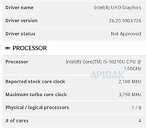- Joined
- Oct 9, 2007
- Messages
- 47,675 (7.43/day)
- Location
- Dublin, Ireland
| System Name | RBMK-1000 |
|---|---|
| Processor | AMD Ryzen 7 5700G |
| Motherboard | Gigabyte B550 AORUS Elite V2 |
| Cooling | DeepCool Gammax L240 V2 |
| Memory | 2x 16GB DDR4-3200 |
| Video Card(s) | Galax RTX 4070 Ti EX |
| Storage | Samsung 990 1TB |
| Display(s) | BenQ 1440p 60 Hz 27-inch |
| Case | Corsair Carbide 100R |
| Audio Device(s) | ASUS SupremeFX S1220A |
| Power Supply | Cooler Master MWE Gold 650W |
| Mouse | ASUS ROG Strix Impact |
| Keyboard | Gamdias Hermes E2 |
| Software | Windows 11 Pro |
A lot of us could be wondering how Intel could number its client-segment processors after the i9-9980XE, or the 9th generation Core in general, and hoping for a major branding change or at least a change in the model numbering scheme. It turns out, Intel will brazen it out with a 5-digit model number and stick to the current scheme. Going by this scheme, the successor to the Core i7-9700K could be the Core i7-10700K, for example. Intel jumped from 3-digit to 4-digit as it transitioned from 1st gen Core to 2nd gen as it ran out of 3-digit numbers with the Core i7-9xx. It's now running out of 4-digit numbers.
Evidence of 5-digit number surfaced when Thai enthusiast TUM_Apisak tweeted a screenshot of a UL Benchmarks Systeminfo page describing an unreleased Core i5-10210U, which is probably a mobile processor based on the 10 nm "Ice Lake-U" silicon slated for late-2019. With a nominal clock-speed of 1.60 GHz and "reported" speed of 2.10 GHz, the Turbo Boost frequency of this 4-core/8-thread chip is rated at almost 3.80 GHz. Japanese enthusiast Komachi Ensaka confirmed this with three other model numbers: i3-10110U, i5-10510U, and i7-10710U.

View at TechPowerUp Main Site
Evidence of 5-digit number surfaced when Thai enthusiast TUM_Apisak tweeted a screenshot of a UL Benchmarks Systeminfo page describing an unreleased Core i5-10210U, which is probably a mobile processor based on the 10 nm "Ice Lake-U" silicon slated for late-2019. With a nominal clock-speed of 1.60 GHz and "reported" speed of 2.10 GHz, the Turbo Boost frequency of this 4-core/8-thread chip is rated at almost 3.80 GHz. Japanese enthusiast Komachi Ensaka confirmed this with three other model numbers: i3-10110U, i5-10510U, and i7-10710U.

View at TechPowerUp Main Site













